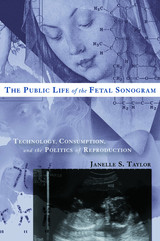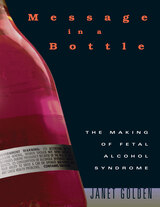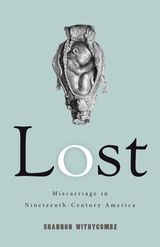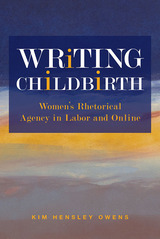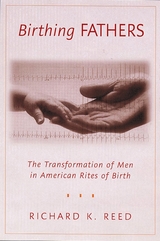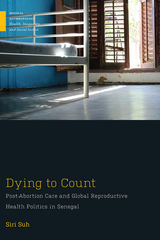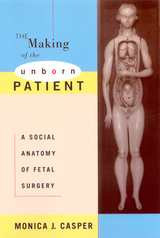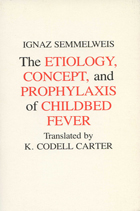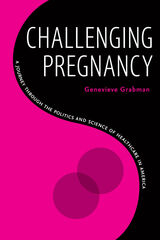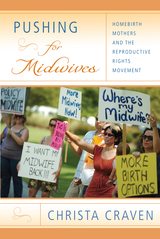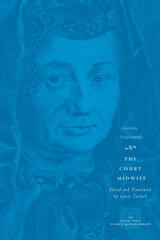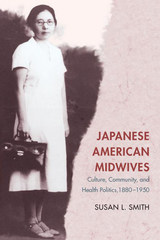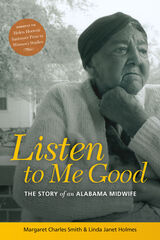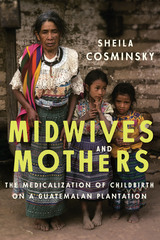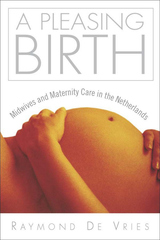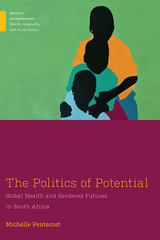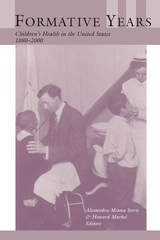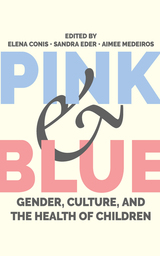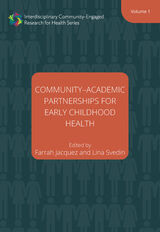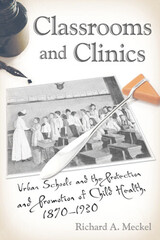Midwifery and Childbirth in America
by Judith Rooks
Temple University Press, 1999
eISBN: 978-1-4399-0623-1 | Paper: 978-1-56639-711-7 | Cloth: 978-1-56639-565-6
Library of Congress Classification RG950.R66 1997
Dewey Decimal Classification 362.198202330973
eISBN: 978-1-4399-0623-1 | Paper: 978-1-56639-711-7 | Cloth: 978-1-56639-565-6
Library of Congress Classification RG950.R66 1997
Dewey Decimal Classification 362.198202330973
ABOUT THIS BOOK | AUTHOR BIOGRAPHY | REVIEWS | TOC
ABOUT THIS BOOK
Childbirth is both a profound experience and a contested subject. The experience of women has complex medical, historical, cultural, and public policy dimensions. In this book, Judith Rooks achieves the rare feat of bringing these dimensions together in a way that can be appreciated by health care planners, midwives, physicians, and women considering pregnancy.
The author vividly describes the history of struggle among health care providers over the meaning and handling of the birth process. The medical model and the midwifery model continue to collide today, the former focusing on pathology and monitoring the patient for it, the latter focusing on birth as a normal, healthy process.
The education and professional training of those who care for women during pregnancy, childbirth, and the important postpartum period reflects these divisions. Obstetrics, family physicians, midwives, nurses, and others play roles in providing the necessary care. In focusing on midwives, Rooks deals fairly and sensitively between certified nurse-midwives and direct-entry midwives, most of whom lack formal educational preparation in midwifery.
This book describes clearly and with documented scientific evidence the specific benefits of the midwifery approach to the care of pregnant women and their families. In clear language accessible to the lay reader, Rooks summarizes the research on the unintended effects of obstetrical interventions, such as episiotomies, epidurals, C-sections, and continuous electronic fetal heart monitoring, and the effectiveness and important benefits of an approach that focuses on the positive potential of childbearing, as contrasted with a narrow focus of potential for pathology. While she acknowledges the importance of access to medical care, extensive research shows the advantages of the midwifery approach. Much that passes for "routine" obstetric care in the United States has been found to be unnecessary, ineffective, or even harmful when applied to women with normal pregnancies.
The arguments over the control of childbirth are set in the context of recent changes in health care, including the current transition to managed care; the impact of the women's movement and movements for natural childbirth, home birth, and breastfeeding; and women's fear of and concern about the pain associated with labor. Rooks also explains the influence of the reports and recommendations of prestigious scientific and health-policy commissions and of federal initiatives and programs on the care provided to pregnant women in this country. She contrasts U.S. practices with those of comparable industrialized countries like the European states, Canada, Australia, New Zealand, and Japan.
The author vividly describes the history of struggle among health care providers over the meaning and handling of the birth process. The medical model and the midwifery model continue to collide today, the former focusing on pathology and monitoring the patient for it, the latter focusing on birth as a normal, healthy process.
The education and professional training of those who care for women during pregnancy, childbirth, and the important postpartum period reflects these divisions. Obstetrics, family physicians, midwives, nurses, and others play roles in providing the necessary care. In focusing on midwives, Rooks deals fairly and sensitively between certified nurse-midwives and direct-entry midwives, most of whom lack formal educational preparation in midwifery.
This book describes clearly and with documented scientific evidence the specific benefits of the midwifery approach to the care of pregnant women and their families. In clear language accessible to the lay reader, Rooks summarizes the research on the unintended effects of obstetrical interventions, such as episiotomies, epidurals, C-sections, and continuous electronic fetal heart monitoring, and the effectiveness and important benefits of an approach that focuses on the positive potential of childbearing, as contrasted with a narrow focus of potential for pathology. While she acknowledges the importance of access to medical care, extensive research shows the advantages of the midwifery approach. Much that passes for "routine" obstetric care in the United States has been found to be unnecessary, ineffective, or even harmful when applied to women with normal pregnancies.
The arguments over the control of childbirth are set in the context of recent changes in health care, including the current transition to managed care; the impact of the women's movement and movements for natural childbirth, home birth, and breastfeeding; and women's fear of and concern about the pain associated with labor. Rooks also explains the influence of the reports and recommendations of prestigious scientific and health-policy commissions and of federal initiatives and programs on the care provided to pregnant women in this country. She contrasts U.S. practices with those of comparable industrialized countries like the European states, Canada, Australia, New Zealand, and Japan.
AUTHOR BIOGRAPHY
Judith Pence Rooks, a past president of the American College of Nurse Midwives, has taught in a school of nursing, a school of medicine, and a midwifery school associated with the historic Frontier Nursing Service in Kentucky. She was the Principle Investigator for the National Birth Center Study, which was conducted at the Columbia University School of Public Health. She reported the results in the New England Journal of Medicine. She has worked as an epidemiologist at the U.S. Center for Disease Control and an "expert" in the Office of the Surgeon General. In 1993 she received the Martha May Eliot Award for exceptional service to mothers and children from the American Public Health Association.
REVIEWS
"...clear, articulate, and well-researched work.... [It] is a treasure trove of information and resources to everyone who works in the maternity services, to policy-makers, and to women. No library or bookshelf should be without it. This scholarly treatise is the most exhaustive, balanced, and comprehensive book on midwifery that has been written, and it will serve as an impetus and inspiration to a broad audience."
—Birth
—Birth
"We have been waiting a long time for this book: a comprehensive, readable, and authoritative discussion of the important role of midwifery in the United States. It will spark a passionate—and long overdue—dialogue about the way pregnant women are taken care of in this country."
—Roger A. Rosenblatt, MD, MPH, Professor and Vice Chair of the Department of Family Medicine, University of Washington, Seattle
—Roger A. Rosenblatt, MD, MPH, Professor and Vice Chair of the Department of Family Medicine, University of Washington, Seattle
"Rooks has written a comprehensive, balanced and eminently readable book."
—The Journal of the Association for Research on Mothering
TABLE OF CONTENTS
CONTENTS
List of Tables
Foreword by Charles S. Mahan, M.D.
Preface
Organization and Objectives
Acknowledgments
Chapter 1
What Is Midwifery?
Etymology
The Care of Pregnant Women: Separation into Two Different Professions
Varying Definitions and Kinds of Midwives
The International Definition of a Midwife
How Does a Midwife Differ from a Traditional Birth Attendant?
America's Many Kinds of Midwives
Chapter 2
Brief History of Midwifery in the West
Antecedents: Midwifery from Earliest History Through the Middle Ages
Development of Midwifery Education in France
"Man-Midwives" and the Increasing Role of Doctors
Midwifery and Obstetrics in the British Isles
Midwifery in the United States: Colonial Times Through the Nineteenth Century
Lack of Licensure and Regulation of Midwives
Midwifery at the Turn of the Century
The Real Causes of High Maternal and Infant Mortality Rates
Development of Obstetric Nursing
The Natural Childbirth and Breast-Feeding Movements Begin
Chapter 3
The Begging of Nurse-Midwifery
Mary Breckinridge and the Frontier Nursing Service
The Maternity Center Association: Beginnings of Nurse-Midwifery Education
The Work of the First Nurse-Midwives
The Origins and the First Work of the American College Nurse-Midwives
The More into University Medical Centers and High-Volume Charity Hospitals
Chapter 4
Midwifery Amid the Social Movements of the 1960s and 1970s
Support for Nurse-Midwives as Health Care Providers for the Poor
Special Nurse-Midwifery Services for Care of Pregnant Adolescents
Grouping Nurse-Midwives with Nurse Practitioners and Physician Assistants
The Impact of Major Federal Government Programs
Childbirth Care During the 1960s and 1970s
Unanticipated Effects of the Risk Approach to Maternity Care
Home Births and the Origins of a New Kind of Lay Midwife
The Farm in Summertown, Tennessee
The Birth Collective at Fremont Women's Clinic in Seattle
The Birth Center of Santa Cruz
Criticism of Medicine and the Reaction of Obstetricians to Lay Midwives
The Reactions of Nurse-Midwives
Development of the ACNM's System of Quality Assurance
Core Competencies and Accreditation to Ensure Quality Education
Ensuring the Competence of Nurse-Midwives at Entrance into the Profession
A Working Relationship with Obstetricians
Clear Definitions and Exclusive Criteria for a Certified Nurse-Midwife
Progress in Nurse-Midwifery Education During the 1970s
Changes in Nurse-Midwifery Clientele and Practice
Nurse-Midwives Move into the Private Sector
Development of Free-Standing Birth Centers
Nurse-Midwifery in the U.S. Military Services
Early Models of Direct-Entry Midwifery Training
The Seattle Midwifery School
The Arizona School of Midwifery
Precepted Experience at a High-Volume Birth Center
Correspondence Courses
Short Workshops
Increasing Physician Resistance to Nurse-Midwives
Chapter 5
Maternal and Infant Health and the Health Care System, 1980-1995
High Cost of Hospital Care for Uninsured Pregnant Women and Newborns
Medical Efforts to Constrain Midlevel Health Care Providers
The American Academy of Family
Physicians' Position on Nurse-Midwives
The American College of Obstetricians and Gynecologists' Position
Importance of Nurse-Midwives' Relationships with Physicians
Medical Opposition to Lay Midwives
The Medical (and Midwifery) Malpractice Liability Insurance Crisis
Impact on Nurse-Midwifery
Impact on Direct-Entry Midwives
Increased Use of Alternative Health Care
Development of a System of Supports to Ensure Quality Care in Birth Centers
The National Birth Center Study
How to Start a Birth Center Workshops
Trends in Hospital Care During Labor and Delivery
Efforts to Reduce the Rate of Cesarean Sections
Factors Associated with Higher or Lower Cesarean Delivery Rates
Low Cesarean Rates Associated with Birth Centers and Care by Midwives
"Active Management of Labor" as a Way to Reduce the Cesarean Rate
Effect of a Constant Supportive Companion Throughout Labor
Educational Approaches, Clinical Guidelines, and Peer Review
Eliminating Financial Incentives
America's High Rates of Low Birth Weight and Infant Mortality
Focus on Prenatal Care
Access to Effective Reproductive Health Care for Socioeconomically High-Risk Women
Health Objectives for the Nation
Reasons for Poor Access to Effective Care
Reproductive Health Care Providers Prenatal Care
Care During Labor and Delivery
Obstetrician-Gynecologists
Family Practice Physicians
Physician Assistants
Access to Care for Rural Women
Recommendations to Increase Use of CNMs to Increase Access to Care
Implementation of the Recommendations About Midwives
Expansion of Medicaid Eligibility
Trends in the Numbers of Births and the Characteristics of Childbearing Women
What Kind of Maternity Care Do Women Want?
Managed Health Care and the Changing Health Care System
Aggressive Growth of Private For-Profit Managed Care Organizations
Effects on Medicaid
Effects on Public Hospitals
Reduced Government Health Care Budgets
Primary Care Providers as Gatekeepers
Small, Perhaps Transient Cost Reductions, and Concerns About Choice, Access, and Quality of Care
Effects on Health Care Providers
Effects of For-Profit Managed Care on Indigent Pregnant Women
Chapter 6
Midwifery in America: Philosophy, Objectives, and Body of Knowledge
How Does Midwifery Differ from the Care Provided by Physicians?
A Focus on What is Normal Versus a Focus on Pathology
Overlapping but Unique Fields of Knowledge
Differences in Beliefs about the Nature of Pregnancy and Birth
Dr. Michael Odent and "The Undisturbed Birth"
Emphasis on Emotional, Social, and Environmental Factors
Beliefs About the Role of the Client Versus That of the Health Professional
Less Narrow Definitions of Normal Objectives of the Care
Development of the Body of Knowledge
Data on the Effectiveness of Care During Pregnancy and Childbirth
Gaps in the Base of Essential Information
Research on Normal Pregnancy
Research on Midwifery Practice
Contributions of American Direct-Entry Midwives
Chapter 7
Midwifery in America, 1980-1994: Percent of Births, Place of Birth, and Clientele
Birth Certificates -- Source of National Natality Data
Underreporting of Births Attended by Midwives
Trends in Place of Birth and Birth Attendants
Birth Sites
Birth Attendants
What Kinds of Women Use Midwives?
Women Whose Out-of-Hospital Birth Were Attended by Midwives, 1975-1988
Ethnicity of Women Whose Births Were Attended by Midwives, 1982-1989
Women Whose Births Were Attended by CNMs in Hospitals, 1988 and 1989
Women Whose Births Were Attended by CNMs in Birth Centers
Women Whose Births Were Attended by Other Midwives in Birth Centers, 1989
Women Who Have Home Births
States That Have a Relatively High Proportion of Midwife-Attended Birhts
Risk Factors Among Women Served by Midwives
Chapter 8
Nurse-Midwifery in America 1980-1995
Laws that Regulate the Practice of Nurse-Midwifery
Prescription Privileges and Mandated Third-Party Payment
New Legislative Issues
What Boards Regulate Nurse-Midwifery Practice?
Legal Requirements for ACNM Certification
Mandated Master's or Bachelor's Degrees
Defining Episiotomies as Surgery and Thus as the Practice of Medicine
New York's New Midwifery Law
Nurse-Midwifery Education
The Role of the ACNM Core Competencies
Nurse-Midwifery Education During the Early 1980s
Identifying Problems and Setting Goals
Expansion of Clinical Learning Sites
Focus on the Role and Skill of the Educator
The First Distance Learning Program of Nurse-Midwives
Distance Learning for Nurses Throughout the Nation
Increasing Numbers of Educational
Programs, Students, and Graduates
The Controversy Regarding Mandatory Degrees
Flexible Programs That Accept Students a Variety of Backgrounds
Financial Support of Nurse-Midwifery Education
Quality Assurance
Accreditation of Nurse-Midwifery Education Programs
Examination and Certification of Nurse-Midwives at Entry into Practice
Certification of Nurse-Midwives Educated in Other Countries
Incorporating New Procedures into Nurse-Midwifery Practice
Peer Review
Data Describing Nurse-Midwives
Nurse-Midwifery Practice as Defined by the ACNM Core Competencies
An Expanding Scope of Practice
ACNM Support for Home Births
Extending Nurse-Midwifery Practice Beyond the Age of Reproduction
New Procedures and Approaches: Care of Women with Complications
Nurse-Midwives as Primary Care Providers
Rescinding a Policy that Prohibited Performing Abortions
Nurse-Midwives' Practice Circumstances
Where Do Nurse-Midwives Work?
CNMs Who Attend Births
Nurse-Midwives' Use of Time During Clinical Care
Findings from the Public Citizen's Health Research Group 1994 Survey
Nurse-Midwifery Practice Models
Nurse-Midwifery Practice in Free-Standing Birth Centers
Nurse-Midwifery Services in Tertiary Academic Hospitals
Practice in Small Towns and Rural Areas
Nurse-Midwifery Services to Meet the Needs of Special Populations
Nurse-Midwifery in Health Maintenance Organizations
Home Births
Collaborations with Physicians
Medical Collaboration in a Nurse-Midwifery Practice or Service
Role of Physicians in a Medical/Midwifery Partnership or Team
ACNM's Agreements and Disagreements with ACOG
Collaboration with Family Physicians
Supervision and Vicarious Legal Liability
Barriers and Supports to Nurse-Midwifery Practice
Findings from National Studies
Professional Liability Insurance
Prescriptive Authority
Hospital Privileges
Third-Party Payment for Health Care Relationships with Physicians
Antitrust Issues
The Mass Movement to Managed Care
Mutual Support, But Significant Disagreements with Nursing
Chapter 9
Development of Direct-Entry Midwifery, 1980-1995
Legal Status
Summary of State Laws Affecting Direct-Entry Midwives
Laws That Require Three Years of Formal Midwifery Education
State Midwifery Organizations
Consumer Support
The Midwives' Alliance of North America
Membership in the International Confederation of Midwives
Development of Standards and Qualifications
MANA's Statement of Values and Ethics
Ambivalence About Certification
MANA Core Competencies for Basic Midwifery Practice
Data Collection and Research
Seminars and an Interorganizational Work Group on Midwifery Education
The Evolution of a Process to Certify Professional Direct-Entry Midwives
The North American Registry Exam for Midwives
The Decision to Develop a National Certification Process
Job and Task Analysis and Development of a Manual Skills Exam
NARM's Certification Process
Informal Educational Opportunities
Study Groups
Apprenticeships
Workshops, Conferences, and Seminars
Books and Other Learning Materials
Schools and Organized Courses
Training Programs Available in 1995
Access to Clinical Experience
Developing a Process to Accredit Direct-Entry Midwifery Education Programs
The Midwifery Education Accreditation Council (MEAC)
Practice
Informed Consent
Prenatal Care
Care During Labor, Birth, and the Postpartum Period
Midwifery Methods to Reduce and Help Women Cope with Pain
Methods and Theories Related to Preventing and Treating Dystocia
The Holistic Health Care Model
Use of Intuition and Other Subjective Knowledge
Christian Midwives
Controversy About the Need to Refer Women with Certain Complications
Medical Care for Women and Newborns with Serious Complications
Recruitment, Selection, and Retention
What Kinds of Women Apply to Direct-Entry Midwifery Schools?
Barriers as Well as Increasing Support for Practice
ACNM's Role in Direct-Entry Midwifery Education and Certification
Challenges for Direct-Entry Midwifery in the United States
Chapter 10
The Quality, Safety, and Effectiveness of Midwifery as Practiced in the United States
The Primacy of Safety
Outcomes of Nurse-Midwifery Care When the Births Occur in Hospitals: Overview
Methodologic Problems in Looking for Causes of Better or Worse Outcomes
Prenatal Care
Prenatal Care Provided by Midwives
Effect of CNM Care on the Incidence of Low and Very Low Birth Weight
MD and RN Care During Labor and Delivery in Hospitals
Support for Women in Labor
Frequent Use of Technical Procedures and Obstetric Interventions
Induction of Labor
Continuous Electronic Fetal Monitoring
Epidural Anesthesia
Routine Intravenous Infusions and Withholding Food and Fluid
Oxytocin Augmentation and Amniotomy: Birth by the Clock
Interventions in the Second Stage of Labor: More Birth by the Clock
Routine or Liberal Use of Episiotomies
Effects of Midwifery Care on Labor and Delivery Interventions
Meta-Analysis of Comparative Studies Published Between 1969 and May 1992
Six Studies Published Since May 1992
Nurse-Midwifery Care and the Rate of Cesarean Deliveries
Summary
Nurturing and Protecting the Newborn and the Family
Breast-Feeding and the Importance of the Period Immediately After Birth
Rooming-In
Support During the First Few Weeks at Home
Contraception
Empowering Women
Chapter 11
Safety of Out-of-Hospital Births in the United States
Why Do Women Have Planned Out-of-Hospital Births?
Difficulty of Conducting Adequate Research on Out-of-Hospital Births
Birth and Death Certificate Data
Data from Specific Out-of-Hospital Birth Practices or Services
Mortality Review Reports
Comparison Groups
International Data
The Netherlands
The United Kingdom
Canada
Limitations of the Application of Data from Other Countries
Area-Wide Data on Out-of-Hospital Birhts
Arizona, 1978-1981
Missouri, 1978-1984
Washington, 1981-1990
Toronto, Ontario, 1983-1988
Vermont, 1989-1994
National Data for 1989
Data on the Safety of Births in Free-Standing Birth Centers
Data on the Safety of Out-of-Hospital Births Attended by Direct-Entry Midwives
Data on the Safety of Home Births Attended by CNMs
Mortality Rates as the Primary Measure for Safety
Maternal Mortality
Intrapartum and Neonatal Morality
Comparison Groups
Interpretation of Morality Rates Summarized in Table 13
Differences in the Proportion of Deaths That Occur During Labor
Postterm Births Result in Higher Morality
Low Morbidity Associated with Home Births
Transfers During the After Labor, and Cesarean Deliveries
Attending High-Risk Births at Home
Summary
Chapter 12
Effects of Midwifery Care on Costs and Other Special Contributions
The Effect of Midwifery on Health Care Costs
Cost Savings from Nurse-Midwifery Care with In-Hospital Births
Cost Savings from Use of Birth Centers and Home Births
Providing Care to Underserved, Hard-to-Serve Women
Research on "Underserved, Hard-to-Serve" Women
Summary
Chapter 13
Midwifery in Canada, Australia, New Zealand, and Japan
Purpose of This Chapter
The International Confederation of Midwives
Midwifery in Europe
Midwifery Education and the European Economic Area Midwives Directives
Having a Baby in Europe -- A WHO Report from the Early 1980s
The Alternative Maternity Care Movement
Midwifery Practice During the Early 1990s
Midwifery in Selected Countries
The Netherlands: Autonomous Midwives and Many Home Births
Legal Status and Protection of Midwives' Role
Place of Birth and Cesarean Deliveries
A National System for Sorting Women by Risk Status
Home Nursing Assistance for Postpartum Mothers
Safe Home Births
A Limited Scope of Practice
Education
Practice Arrangements and Conditions
Great Britain: Demands for a New Approach to Maternity Care
"Changing Childbirth" -- A Mandate to Improve Maternity Care
Midwifery Education and the Resurgence of Direct-Entry Midwifery
Canada
History
Ontario
Quebec
Alberta
British Columbia
Provinces in Line for New Laws: Manitoba and Saskatchewan
The Varying Reactions of Physicians
Australia
History
Recent Events and the Current Situation
Midwifery Education
New Zealand
History
Independent Midwifery Practice
Japan
History
Efforts to Reestablish Midwifery Birthing Homes
Current Practice
Education, Employment, and Retention of Midwives
Chapter 14
The Current Situation and Recommendations for the Future
Two Ways of Viewing Pregnancy and Birth
Favorable and Unfavorable Trends
Brief Recap and the Medicalization of Childbirth in the United States
The Effects and Effectiveness of High-Tech Childbirth Care
The Scientific Evidence
Brief Recap of the Development of Midwifery in the United States
Benefits of the Midwifery Model
Dominance of the Medical Model
Cultural Considerations
Ignorance and Confusion About Midwifery
Fear of Danger
Obstetrician-Gynecologists as Primary-Care Physicians
Pain as a Pivotal Issue
The Effectiveness, Untoward Effects, and Cost of Epidurals
The Nature of Pain During Childbirth
Childbirth Education as an Alternative
Support During Labor as an Alternative
Midwife Approach to Pain Control
Meeting the Needs of Socioeconomically High-Risk Women
Professionals Who Focus on the Needs of Indigent Pregnant Women
Nurse-Midwives' Contributions
High Proportion of Births to Socially Disadvantaged Women
Short-Term Savings or Long-Term Cost Effectiveness?
Recommendations Made by Other Groups
Recommendations from Prestigious National Institutes and Commissions
Recommendations from National Women's Health Organizations
Recommedations from a Consumer Advocacy Organization
The Mother-Friendly Childbirth Initiative
Recommendations to Broaden the Objectives and Focus of Maternity Care
Public Health Service Recommendations on the Content of Prenatal Care
A Focus on the Mother
Watching Our Words
Other Recommendations
Women's Right to Access Both Maternity Care Models
Women's Right to Pain Control
Opportunities to Reduce the Long-Term Cost of Health Care
Training of Physicians, Midwives, Nurses, and Doulas
Recommendations Regarding Birth Centers and Home Births
The Possibility of Achieving These Recommendations
Potential Positive Effects of Managed Health Care
Barriers to Change
Seeking Complementarity
References
Index
List of Tables
Foreword by Charles S. Mahan, M.D.
Preface
Organization and Objectives
Acknowledgments
Chapter 1
What Is Midwifery?
Etymology
The Care of Pregnant Women: Separation into Two Different Professions
Varying Definitions and Kinds of Midwives
The International Definition of a Midwife
How Does a Midwife Differ from a Traditional Birth Attendant?
America's Many Kinds of Midwives
Chapter 2
Brief History of Midwifery in the West
Antecedents: Midwifery from Earliest History Through the Middle Ages
Development of Midwifery Education in France
"Man-Midwives" and the Increasing Role of Doctors
Midwifery and Obstetrics in the British Isles
Midwifery in the United States: Colonial Times Through the Nineteenth Century
Lack of Licensure and Regulation of Midwives
Midwifery at the Turn of the Century
The Real Causes of High Maternal and Infant Mortality Rates
Development of Obstetric Nursing
The Natural Childbirth and Breast-Feeding Movements Begin
Chapter 3
The Begging of Nurse-Midwifery
Mary Breckinridge and the Frontier Nursing Service
The Maternity Center Association: Beginnings of Nurse-Midwifery Education
The Work of the First Nurse-Midwives
The Origins and the First Work of the American College Nurse-Midwives
The More into University Medical Centers and High-Volume Charity Hospitals
Chapter 4
Midwifery Amid the Social Movements of the 1960s and 1970s
Support for Nurse-Midwives as Health Care Providers for the Poor
Special Nurse-Midwifery Services for Care of Pregnant Adolescents
Grouping Nurse-Midwives with Nurse Practitioners and Physician Assistants
The Impact of Major Federal Government Programs
Childbirth Care During the 1960s and 1970s
Unanticipated Effects of the Risk Approach to Maternity Care
Home Births and the Origins of a New Kind of Lay Midwife
The Farm in Summertown, Tennessee
The Birth Collective at Fremont Women's Clinic in Seattle
The Birth Center of Santa Cruz
Criticism of Medicine and the Reaction of Obstetricians to Lay Midwives
The Reactions of Nurse-Midwives
Development of the ACNM's System of Quality Assurance
Core Competencies and Accreditation to Ensure Quality Education
Ensuring the Competence of Nurse-Midwives at Entrance into the Profession
A Working Relationship with Obstetricians
Clear Definitions and Exclusive Criteria for a Certified Nurse-Midwife
Progress in Nurse-Midwifery Education During the 1970s
Changes in Nurse-Midwifery Clientele and Practice
Nurse-Midwives Move into the Private Sector
Development of Free-Standing Birth Centers
Nurse-Midwifery in the U.S. Military Services
Early Models of Direct-Entry Midwifery Training
The Seattle Midwifery School
The Arizona School of Midwifery
Precepted Experience at a High-Volume Birth Center
Correspondence Courses
Short Workshops
Increasing Physician Resistance to Nurse-Midwives
Chapter 5
Maternal and Infant Health and the Health Care System, 1980-1995
High Cost of Hospital Care for Uninsured Pregnant Women and Newborns
Medical Efforts to Constrain Midlevel Health Care Providers
The American Academy of Family
Physicians' Position on Nurse-Midwives
The American College of Obstetricians and Gynecologists' Position
Importance of Nurse-Midwives' Relationships with Physicians
Medical Opposition to Lay Midwives
The Medical (and Midwifery) Malpractice Liability Insurance Crisis
Impact on Nurse-Midwifery
Impact on Direct-Entry Midwives
Increased Use of Alternative Health Care
Development of a System of Supports to Ensure Quality Care in Birth Centers
The National Birth Center Study
How to Start a Birth Center Workshops
Trends in Hospital Care During Labor and Delivery
Efforts to Reduce the Rate of Cesarean Sections
Factors Associated with Higher or Lower Cesarean Delivery Rates
Low Cesarean Rates Associated with Birth Centers and Care by Midwives
"Active Management of Labor" as a Way to Reduce the Cesarean Rate
Effect of a Constant Supportive Companion Throughout Labor
Educational Approaches, Clinical Guidelines, and Peer Review
Eliminating Financial Incentives
America's High Rates of Low Birth Weight and Infant Mortality
Focus on Prenatal Care
Access to Effective Reproductive Health Care for Socioeconomically High-Risk Women
Health Objectives for the Nation
Reasons for Poor Access to Effective Care
Reproductive Health Care Providers Prenatal Care
Care During Labor and Delivery
Obstetrician-Gynecologists
Family Practice Physicians
Physician Assistants
Access to Care for Rural Women
Recommendations to Increase Use of CNMs to Increase Access to Care
Implementation of the Recommendations About Midwives
Expansion of Medicaid Eligibility
Trends in the Numbers of Births and the Characteristics of Childbearing Women
What Kind of Maternity Care Do Women Want?
Managed Health Care and the Changing Health Care System
Aggressive Growth of Private For-Profit Managed Care Organizations
Effects on Medicaid
Effects on Public Hospitals
Reduced Government Health Care Budgets
Primary Care Providers as Gatekeepers
Small, Perhaps Transient Cost Reductions, and Concerns About Choice, Access, and Quality of Care
Effects on Health Care Providers
Effects of For-Profit Managed Care on Indigent Pregnant Women
Chapter 6
Midwifery in America: Philosophy, Objectives, and Body of Knowledge
How Does Midwifery Differ from the Care Provided by Physicians?
A Focus on What is Normal Versus a Focus on Pathology
Overlapping but Unique Fields of Knowledge
Differences in Beliefs about the Nature of Pregnancy and Birth
Dr. Michael Odent and "The Undisturbed Birth"
Emphasis on Emotional, Social, and Environmental Factors
Beliefs About the Role of the Client Versus That of the Health Professional
Less Narrow Definitions of Normal Objectives of the Care
Development of the Body of Knowledge
Data on the Effectiveness of Care During Pregnancy and Childbirth
Gaps in the Base of Essential Information
Research on Normal Pregnancy
Research on Midwifery Practice
Contributions of American Direct-Entry Midwives
Chapter 7
Midwifery in America, 1980-1994: Percent of Births, Place of Birth, and Clientele
Birth Certificates -- Source of National Natality Data
Underreporting of Births Attended by Midwives
Trends in Place of Birth and Birth Attendants
Birth Sites
Birth Attendants
What Kinds of Women Use Midwives?
Women Whose Out-of-Hospital Birth Were Attended by Midwives, 1975-1988
Ethnicity of Women Whose Births Were Attended by Midwives, 1982-1989
Women Whose Births Were Attended by CNMs in Hospitals, 1988 and 1989
Women Whose Births Were Attended by CNMs in Birth Centers
Women Whose Births Were Attended by Other Midwives in Birth Centers, 1989
Women Who Have Home Births
States That Have a Relatively High Proportion of Midwife-Attended Birhts
Risk Factors Among Women Served by Midwives
Chapter 8
Nurse-Midwifery in America 1980-1995
Laws that Regulate the Practice of Nurse-Midwifery
Prescription Privileges and Mandated Third-Party Payment
New Legislative Issues
What Boards Regulate Nurse-Midwifery Practice?
Legal Requirements for ACNM Certification
Mandated Master's or Bachelor's Degrees
Defining Episiotomies as Surgery and Thus as the Practice of Medicine
New York's New Midwifery Law
Nurse-Midwifery Education
The Role of the ACNM Core Competencies
Nurse-Midwifery Education During the Early 1980s
Identifying Problems and Setting Goals
Expansion of Clinical Learning Sites
Focus on the Role and Skill of the Educator
The First Distance Learning Program of Nurse-Midwives
Distance Learning for Nurses Throughout the Nation
Increasing Numbers of Educational
Programs, Students, and Graduates
The Controversy Regarding Mandatory Degrees
Flexible Programs That Accept Students a Variety of Backgrounds
Financial Support of Nurse-Midwifery Education
Quality Assurance
Accreditation of Nurse-Midwifery Education Programs
Examination and Certification of Nurse-Midwives at Entry into Practice
Certification of Nurse-Midwives Educated in Other Countries
Incorporating New Procedures into Nurse-Midwifery Practice
Peer Review
Data Describing Nurse-Midwives
Nurse-Midwifery Practice as Defined by the ACNM Core Competencies
An Expanding Scope of Practice
ACNM Support for Home Births
Extending Nurse-Midwifery Practice Beyond the Age of Reproduction
New Procedures and Approaches: Care of Women with Complications
Nurse-Midwives as Primary Care Providers
Rescinding a Policy that Prohibited Performing Abortions
Nurse-Midwives' Practice Circumstances
Where Do Nurse-Midwives Work?
CNMs Who Attend Births
Nurse-Midwives' Use of Time During Clinical Care
Findings from the Public Citizen's Health Research Group 1994 Survey
Nurse-Midwifery Practice Models
Nurse-Midwifery Practice in Free-Standing Birth Centers
Nurse-Midwifery Services in Tertiary Academic Hospitals
Practice in Small Towns and Rural Areas
Nurse-Midwifery Services to Meet the Needs of Special Populations
Nurse-Midwifery in Health Maintenance Organizations
Home Births
Collaborations with Physicians
Medical Collaboration in a Nurse-Midwifery Practice or Service
Role of Physicians in a Medical/Midwifery Partnership or Team
ACNM's Agreements and Disagreements with ACOG
Collaboration with Family Physicians
Supervision and Vicarious Legal Liability
Barriers and Supports to Nurse-Midwifery Practice
Findings from National Studies
Professional Liability Insurance
Prescriptive Authority
Hospital Privileges
Third-Party Payment for Health Care Relationships with Physicians
Antitrust Issues
The Mass Movement to Managed Care
Mutual Support, But Significant Disagreements with Nursing
Chapter 9
Development of Direct-Entry Midwifery, 1980-1995
Legal Status
Summary of State Laws Affecting Direct-Entry Midwives
Laws That Require Three Years of Formal Midwifery Education
State Midwifery Organizations
Consumer Support
The Midwives' Alliance of North America
Membership in the International Confederation of Midwives
Development of Standards and Qualifications
MANA's Statement of Values and Ethics
Ambivalence About Certification
MANA Core Competencies for Basic Midwifery Practice
Data Collection and Research
Seminars and an Interorganizational Work Group on Midwifery Education
The Evolution of a Process to Certify Professional Direct-Entry Midwives
The North American Registry Exam for Midwives
The Decision to Develop a National Certification Process
Job and Task Analysis and Development of a Manual Skills Exam
NARM's Certification Process
Informal Educational Opportunities
Study Groups
Apprenticeships
Workshops, Conferences, and Seminars
Books and Other Learning Materials
Schools and Organized Courses
Training Programs Available in 1995
Access to Clinical Experience
Developing a Process to Accredit Direct-Entry Midwifery Education Programs
The Midwifery Education Accreditation Council (MEAC)
Practice
Informed Consent
Prenatal Care
Care During Labor, Birth, and the Postpartum Period
Midwifery Methods to Reduce and Help Women Cope with Pain
Methods and Theories Related to Preventing and Treating Dystocia
The Holistic Health Care Model
Use of Intuition and Other Subjective Knowledge
Christian Midwives
Controversy About the Need to Refer Women with Certain Complications
Medical Care for Women and Newborns with Serious Complications
Recruitment, Selection, and Retention
What Kinds of Women Apply to Direct-Entry Midwifery Schools?
Barriers as Well as Increasing Support for Practice
ACNM's Role in Direct-Entry Midwifery Education and Certification
Challenges for Direct-Entry Midwifery in the United States
Chapter 10
The Quality, Safety, and Effectiveness of Midwifery as Practiced in the United States
The Primacy of Safety
Outcomes of Nurse-Midwifery Care When the Births Occur in Hospitals: Overview
Methodologic Problems in Looking for Causes of Better or Worse Outcomes
Prenatal Care
Prenatal Care Provided by Midwives
Effect of CNM Care on the Incidence of Low and Very Low Birth Weight
MD and RN Care During Labor and Delivery in Hospitals
Support for Women in Labor
Frequent Use of Technical Procedures and Obstetric Interventions
Induction of Labor
Continuous Electronic Fetal Monitoring
Epidural Anesthesia
Routine Intravenous Infusions and Withholding Food and Fluid
Oxytocin Augmentation and Amniotomy: Birth by the Clock
Interventions in the Second Stage of Labor: More Birth by the Clock
Routine or Liberal Use of Episiotomies
Effects of Midwifery Care on Labor and Delivery Interventions
Meta-Analysis of Comparative Studies Published Between 1969 and May 1992
Six Studies Published Since May 1992
Nurse-Midwifery Care and the Rate of Cesarean Deliveries
Summary
Nurturing and Protecting the Newborn and the Family
Breast-Feeding and the Importance of the Period Immediately After Birth
Rooming-In
Support During the First Few Weeks at Home
Contraception
Empowering Women
Chapter 11
Safety of Out-of-Hospital Births in the United States
Why Do Women Have Planned Out-of-Hospital Births?
Difficulty of Conducting Adequate Research on Out-of-Hospital Births
Birth and Death Certificate Data
Data from Specific Out-of-Hospital Birth Practices or Services
Mortality Review Reports
Comparison Groups
International Data
The Netherlands
The United Kingdom
Canada
Limitations of the Application of Data from Other Countries
Area-Wide Data on Out-of-Hospital Birhts
Arizona, 1978-1981
Missouri, 1978-1984
Washington, 1981-1990
Toronto, Ontario, 1983-1988
Vermont, 1989-1994
National Data for 1989
Data on the Safety of Births in Free-Standing Birth Centers
Data on the Safety of Out-of-Hospital Births Attended by Direct-Entry Midwives
Data on the Safety of Home Births Attended by CNMs
Mortality Rates as the Primary Measure for Safety
Maternal Mortality
Intrapartum and Neonatal Morality
Comparison Groups
Interpretation of Morality Rates Summarized in Table 13
Differences in the Proportion of Deaths That Occur During Labor
Postterm Births Result in Higher Morality
Low Morbidity Associated with Home Births
Transfers During the After Labor, and Cesarean Deliveries
Attending High-Risk Births at Home
Summary
Chapter 12
Effects of Midwifery Care on Costs and Other Special Contributions
The Effect of Midwifery on Health Care Costs
Cost Savings from Nurse-Midwifery Care with In-Hospital Births
Cost Savings from Use of Birth Centers and Home Births
Providing Care to Underserved, Hard-to-Serve Women
Research on "Underserved, Hard-to-Serve" Women
Summary
Chapter 13
Midwifery in Canada, Australia, New Zealand, and Japan
Purpose of This Chapter
The International Confederation of Midwives
Midwifery in Europe
Midwifery Education and the European Economic Area Midwives Directives
Having a Baby in Europe -- A WHO Report from the Early 1980s
The Alternative Maternity Care Movement
Midwifery Practice During the Early 1990s
Midwifery in Selected Countries
The Netherlands: Autonomous Midwives and Many Home Births
Legal Status and Protection of Midwives' Role
Place of Birth and Cesarean Deliveries
A National System for Sorting Women by Risk Status
Home Nursing Assistance for Postpartum Mothers
Safe Home Births
A Limited Scope of Practice
Education
Practice Arrangements and Conditions
Great Britain: Demands for a New Approach to Maternity Care
"Changing Childbirth" -- A Mandate to Improve Maternity Care
Midwifery Education and the Resurgence of Direct-Entry Midwifery
Canada
History
Ontario
Quebec
Alberta
British Columbia
Provinces in Line for New Laws: Manitoba and Saskatchewan
The Varying Reactions of Physicians
Australia
History
Recent Events and the Current Situation
Midwifery Education
New Zealand
History
Independent Midwifery Practice
Japan
History
Efforts to Reestablish Midwifery Birthing Homes
Current Practice
Education, Employment, and Retention of Midwives
Chapter 14
The Current Situation and Recommendations for the Future
Two Ways of Viewing Pregnancy and Birth
Favorable and Unfavorable Trends
Brief Recap and the Medicalization of Childbirth in the United States
The Effects and Effectiveness of High-Tech Childbirth Care
The Scientific Evidence
Brief Recap of the Development of Midwifery in the United States
Benefits of the Midwifery Model
Dominance of the Medical Model
Cultural Considerations
Ignorance and Confusion About Midwifery
Fear of Danger
Obstetrician-Gynecologists as Primary-Care Physicians
Pain as a Pivotal Issue
The Effectiveness, Untoward Effects, and Cost of Epidurals
The Nature of Pain During Childbirth
Childbirth Education as an Alternative
Support During Labor as an Alternative
Midwife Approach to Pain Control
Meeting the Needs of Socioeconomically High-Risk Women
Professionals Who Focus on the Needs of Indigent Pregnant Women
Nurse-Midwives' Contributions
High Proportion of Births to Socially Disadvantaged Women
Short-Term Savings or Long-Term Cost Effectiveness?
Recommendations Made by Other Groups
Recommendations from Prestigious National Institutes and Commissions
Recommendations from National Women's Health Organizations
Recommedations from a Consumer Advocacy Organization
The Mother-Friendly Childbirth Initiative
Recommendations to Broaden the Objectives and Focus of Maternity Care
Public Health Service Recommendations on the Content of Prenatal Care
A Focus on the Mother
Watching Our Words
Other Recommendations
Women's Right to Access Both Maternity Care Models
Women's Right to Pain Control
Opportunities to Reduce the Long-Term Cost of Health Care
Training of Physicians, Midwives, Nurses, and Doulas
Recommendations Regarding Birth Centers and Home Births
The Possibility of Achieving These Recommendations
Potential Positive Effects of Managed Health Care
Barriers to Change
Seeking Complementarity
References
Index
See other books on: America | Childbirth | Health Policy | Maternal health services | Midwifery
See other titles from Temple University Press
Nearby on shelf for Gynecology and obstetrics / Obstetrics / Maternal care. Prenatal care services:
9780813543642
9780813562391

